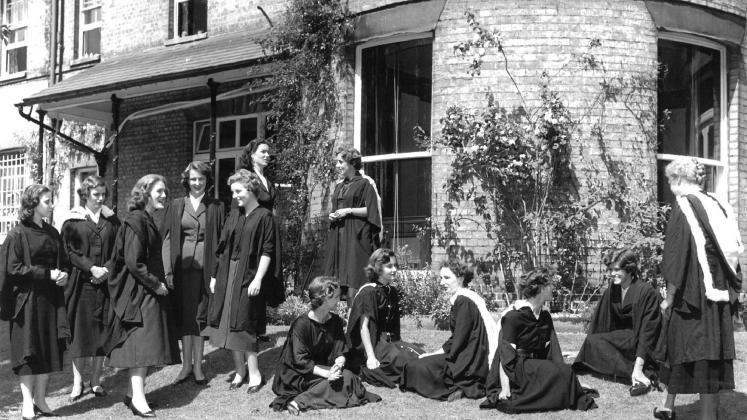70th Anniversary Exhibition
Special exhibition opens in celebration of College's 70th anniversary (until end of 2024)

Seventy years ago, our College opened as the third foundation for women at the University of Cambridge, on a shoestring and in a borrowed building with just 16 students.
Crammed into a house on Silver Street (now part of Darwin College), that first cohort of undergraduates barely had room to squash round a table for dinner. Our founding President – the redoubtable chemistry lecturer Rosemary Murray - not only taught the students but patrolled the building with her screwdriver, carrying out repairs and putting up towel rails.
Pioneering women
The College’s modest beginnings were no surprise: it had been established in the teeth of indifference and even opposition in a university that had granted degrees to women only in 1947 – the last of any UK higher education institution. At the time, there were just two colleges for women at Cambridge, Newnham and Girton, and competition for admission was fierce. Frustrated with the lack of opportunities for young women wanting a first-rate education, a group of 44 pioneering women associated with the University - headed by Margareta (Greta) Burkill - had begun to campaign for more places for female students.
The campaigners, navigating a wall of bureaucracy, were told that the new college would not receive any financial help from the University. Founded with an endowment of £25,000 – received from other colleges, including King’s, St John’s and Trinity, and donations raised by girls’ schools from cake sales - the new ‘recognised institution’ was known only as New Hall.
To mark the ground-breaking opening of Cambridge’s third foundation for women, now one of only two remaining higher education institutions for women in the UK, we are today opening an exhibition highlighting our extraordinary history. The display, featuring original images and archival material, will be on show in the College until the end of 2024.
Progressive and free-thinking
Despite its hand-to-mouth early days, the new foundation flourished, and ten years on moved into iconic purpose-built modernist buildings, designed - by the architects who would go on to build the Barbican - as a concrete manifesto for women’s education. New Hall, with a radical new entrance exam and unburdened by ancient rules, gained a reputation as an open, progressive and free-thinking place to be, building its own traditions and continuing to value women’s academic achievement.
In 1972, the foundation received its Charter and was finally a full college of the University of Cambridge. Three years later Rosemary Murray became the first woman Vice Chancellor of Cambridge, and, as the College expanded through the 1970s, New Hall Fellows campaigned for women’s rights within the university and higher education, particularly in terms of childcare.
Further expansion followed in the 1980s, and, in another key development, the College hosted the American conceptual artist, Mary Kelly, for a year. One of her works, Extase, was bought by the College and inspired a wider appeal to women artists to donate works. Their extraordinary act of collective giving formed the basis of what is now The Women’s Art Collection – the largest collection of art by women in Europe. The Collection now comprises over 600 works, most of which are on display within the College’s grounds and buildings.
Record-breaking gift
By the 1990s, New Hall was struggling financially amid government funding changes, as repairs were needed to its concrete buildings. With bankruptcy a real prospect, its future was secured thanks to a generous endowment of £30 million by alumna Ros Smith and her then-husband Steve Edwards: then the largest single gift to a UK higher education institution. The College was now properly endowed, and was renamed Murray Edwards in recognition of its pathbreaking founding president and the generosity of its donors.
Today, under the Presidency of Dorothy Byrne, former Head of News at Channel 4, the College is thriving. The College’s history and strategic direction have always focused on gendered inequalities facing women, and we continue to highlight these issues in conferences, talks, debates and other events. Murray Edwards College continues to proudly be a college for women, while including and warmly welcoming men as Fellows, staff and visitors.
Academic support
The College also aims to expand its outreach work to students from disadvantaged and historically under-represented groups, offering a range of academic support to help brilliant young women from these groups compete for entry to Cambridge on an equal footing. The support of the College’s network of alumnae is vital to this work.
For the next 70 years and beyond, Murray Edwards College will be leading the way in promoting academic excellence, careers success and personal wellbeing for exceptional young women. It aims to empower students to be confident, successful and happy, and to offer outstanding young women from all backgrounds an academically excellent Cambridge University education in a stimulating and supportive environment.
We are celebrating our seven decades with our exhibition and a range of other events. We welcome visitors, and are open to the public every day. Admission is free.
"New Hall itself was refreshingly free from tradition. Nobody could say: ‘But it has always been done this way’ - and so we felt free to discuss and determine how things would be done, and I think New Hall students were recognised generally as people who were ready to re-think out-worn conventions. "